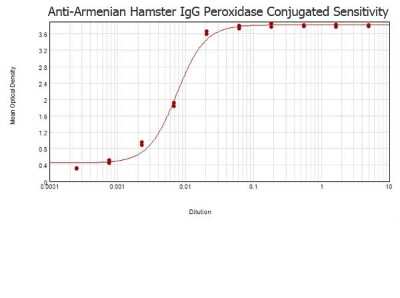Goat anti-Armenian Hamster IgG (H+L) Secondary Antibody [HRP]
Novus Biologicals, part of Bio-Techne | Catalog # NB100-2066


Conjugate
Catalog #
Key Product Details
Species Reactivity
Armenian Hamster
Applications
ELISA, Immunohistochemistry, Western Blot
Label
HRP
Antibody Source
Polyclonal Goat IgG
Concentration
LYOPH mg/ml
Product Specifications
Immunogen
Armenian Hamster IgG whole molecule
Specificity
Greatly diminished reactivity will occur against Golden Syrian Hamster IgG.
Clonality
Polyclonal
Host
Goat
Isotype
IgG
Description
Store vial at 4C prior to restoration. For extended storage aliquot contents and freeze at -20C or below. Avoid cycles of freezing and thawing. Centrifuge product if not completely clear after standing at room temperature. This product is stable for several weeks at 4C as an undiluted liquid. Dilute only prior to immediate use.
This product was prepared from monospecific antiserum by immunoaffinity chromatography using Armenian Hamster IgG coupled to agarose. Assay by immunoelectrophoresis resulted in a single precipitin arc against anti-Peroxidase, anti-Goat Serum, Armenian Hamster IgG and Armenian Hamster Serum
This product was prepared from monospecific antiserum by immunoaffinity chromatography using Armenian Hamster IgG coupled to agarose. Assay by immunoelectrophoresis resulted in a single precipitin arc against anti-Peroxidase, anti-Goat Serum, Armenian Hamster IgG and Armenian Hamster Serum
Scientific Data Images for Goat anti-Armenian Hamster IgG (H+L) Secondary Antibody [HRP]
ELISA: Goat anti-Armenian Hamster IgG (H+L) Secondary Antibody [HRP] [NB100-2066] - ELISA results of purified Goat anti-Armenian Hamster IgG (H+L) Secondary Antibody [HRP] tested against purified Armenian Hamster IgG. Each well was coated in duplicate with 1.0 ug of Armenian Hamster IgG
Applications for Goat anti-Armenian Hamster IgG (H+L) Secondary Antibody [HRP]
Application
Recommended Usage
ELISA
1:25000
Immunohistochemistry
1:1000 - 1:5000
Western Blot
1:1000 - 1:5000
Application Notes
This product has been tested by ELISA and is designed for Western Blotting, ELISA and Immunohistochemistry. HRP conjugated secondary antibodies can also be used for a variety of other applications such as Assay Development.
NOTE: Do NOT add Sodium Azide (it inhibits HRP irreversibly).
NOTE: Do NOT add Sodium Azide (it inhibits HRP irreversibly).
Please Note: Optimal dilutions of this antibody should be experimentally determined.
Formulation, Preparation, and Storage
Purification
Immunogen affinity purified
Reconstitution
Reconstitute with 1.0 ml deionized water (or equivalent).
Formulation
Lyophilized from 0.02 M Potassium Phosphate, 0.15 M Sodium Chloride, pH 7.2, 10 mg/mL Bovine Serum Albumin (BSA) - Immunoglobulin and Protease free
Preservative
0.01% Gentamicin Sulfate
Concentration
LYOPH mg/ml
Shipping
The product is shipped with polar packs. Upon receipt, store it immediately at the temperature recommended below.
Stability & Storage
Store lyophilized antibody at 4C in the dark. Aliquot reconstituted liquid and store at -20C. Avoid freeze-thaw cycles.
Background: IgG (H+L)
The 4 IgG subclasses, sharing 95% amino acid identity, include IgG1, IgG2, IgG3, and IgG4 for humans and IgG1, IgG2a, IgG2b, and IgG3 for mice. The relative abundance of each human subclass is 60% for IgG1, 32% for IgG2, 4% for IgG3, and 4% for IgG4. In an IgG deficiency, there may be a shortage of one or more subclasses (4).
References
1. Painter RH. (1998) Encyclopedia of Immunology (Second Edition). Elsevier. 1208-1211
2. Chapter 9 - Antibodies. (2012) Immunology for Pharmacy. Mosby 70-78
3. Schroeder H, Cavacini, L. (2010) Structure and Function of Immunoglobulins. J Allergy Clin Immunol. 125(2 0 2): S41-S52. PMID: 20176268
4. Vidarsson G, Dekkers G, Rispens T. (2014) IgG subclasses and allotypes: from structure to effector functions. Front Immunol. 5:520. PMID: 25368619
Additional IgG (H+L) Products
Product Documents for Goat anti-Armenian Hamster IgG (H+L) Secondary Antibody [HRP]
Product Specific Notices for Goat anti-Armenian Hamster IgG (H+L) Secondary Antibody [HRP]
This product is for research use only and is not approved for use in humans or in clinical diagnosis. Secondary Antibodies are guaranteed for 1 year from date of receipt.
